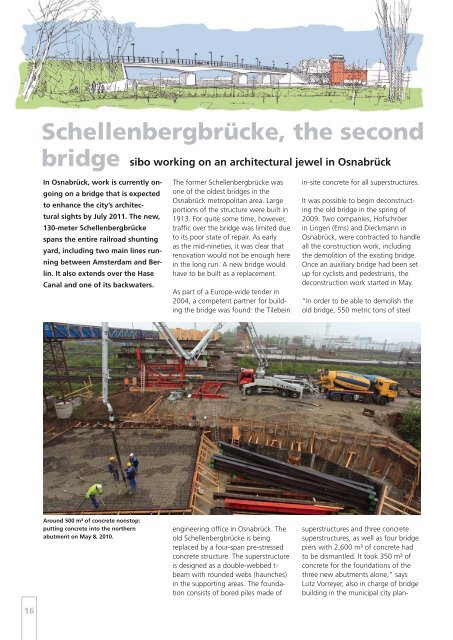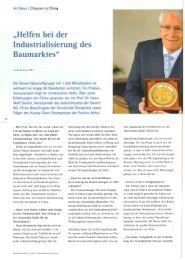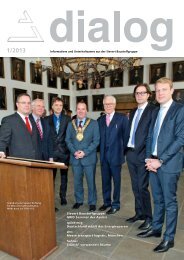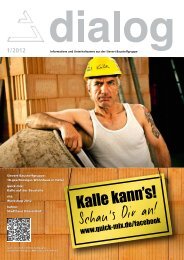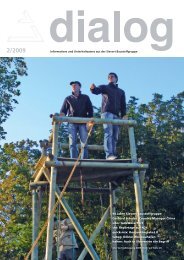1/2010 - Sievert AG
1/2010 - Sievert AG
1/2010 - Sievert AG
Create successful ePaper yourself
Turn your PDF publications into a flip-book with our unique Google optimized e-Paper software.
16<br />
Schellenbergbrücke, the second<br />
bridge sibo working on an architectural jewel in Osnabrück<br />
In Osnabrück, work is currently ongoing<br />
on a bridge that is expected<br />
to enhance the city’s architectural<br />
sights by July 2011. The new,<br />
130-meter Schellenbergbrücke<br />
spans the entire railroad shunting<br />
yard, including two main lines running<br />
between Amsterdam and Berlin.<br />
It also extends over the Hase<br />
Canal and one of its backwaters.<br />
Around 500 m³ of concrete nonstop:<br />
putting concrete into the northern<br />
abutment on May 8, <strong>2010</strong>.<br />
The former Schellenbergbrücke was<br />
one of the oldest bridges in the<br />
Osnabrück metropolitan area. Large<br />
portions of the structure were built in<br />
1913. For quite some time, however,<br />
traffic over the bridge was limited due<br />
to its poor state of repair. As early<br />
as the mid-nineties, it was clear that<br />
renovation would not be enough here<br />
in the long run. A new bridge would<br />
have to be built as a replacement.<br />
As part of a Europe-wide tender in<br />
2004, a competent partner for building<br />
the bridge was found: the Tilebein<br />
engineering office in Osnabrück. The<br />
old Schellenbergbrücke is being<br />
replaced by a four-span pre-stressed<br />
concrete structure. The superstructure<br />
is designed as a double-webbed tbeam<br />
with rounded webs (haunches)<br />
in the supporting areas. The foundation<br />
consists of bored piles made of<br />
in-site concrete for all superstructures.<br />
It was possible to begin deconstructing<br />
the old bridge in the spring of<br />
2009. Two companies, Hofschröer<br />
in Lingen (Ems) and Dieckmann in<br />
Osnabrück, were contracted to handle<br />
all the construction work, including<br />
the demolition of the existing bridge.<br />
Once an auxiliary bridge had been set<br />
up for cyclists and pedestrians, the<br />
deconstruction work started in May.<br />
“In order to be able to demolish the<br />
old bridge, 550 metric tons of steel<br />
superstructures and three concrete<br />
superstructures, as well as four bridge<br />
piers with 2,600 m³ of concrete had<br />
to be dismantled. It took 350 m³ of<br />
concrete for the foundations of the<br />
three new abutments alone,” says<br />
Lutz Vorreyer, also in charge of bridge<br />
building in the municipal city plan-


